U is for UV Light
U is the next letter in the A to Z Science series for toddlers and preschoolers at Inspiration Laboratories. U is for UV Light. Try this simple exploration to explore ultraviolet light with your child.
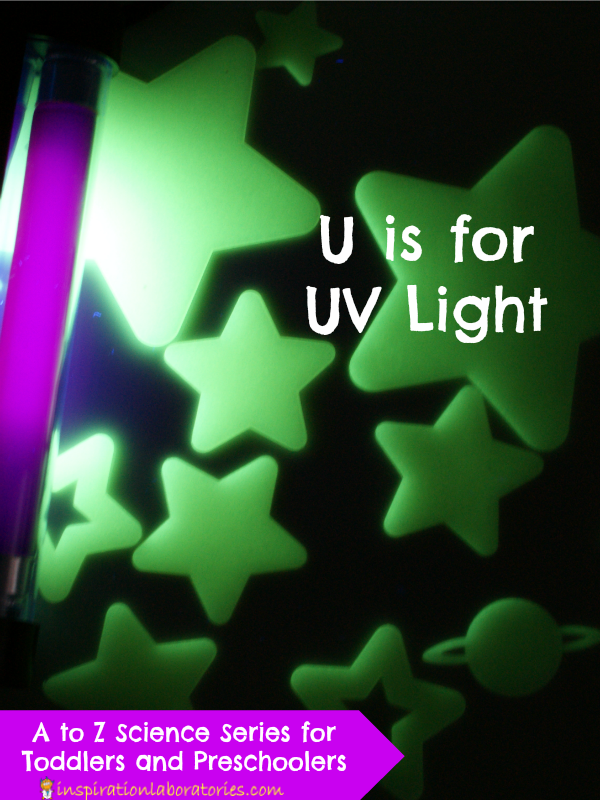
U is for UV Light
Safety Precautions First
Ultraviolet light can be dangerous depending on the type of light and exposure time. Read the information that came with your black light and be sure it is meant for entertainment use. Some black lights are created for medical or scientific purposes, so don’t just buy whatever light you happen to see online. Those in the party or Halloween sections are most likely safe. Read their precautions and directions to double check. Some black lights require wearing special UV safety glasses or goggles and covering exposed skin or minimizing the length of exposure. UV light is the type of light that causes sunburns after all.
Do not look directly into the black light. Do not remove the covering or shield of the black light.
UV Light or Flashlight – Which Works Better?
This exploration looks at glow in the dark stars. They need to absorb light before they will glow. What kind of light will make them glow brighter – UV light or a flashlight? We used a super cheap flashlight (not LED) and an inexpensive flashlight lantern (also not LED). Use whatever flashlight you have available. See our setup below.
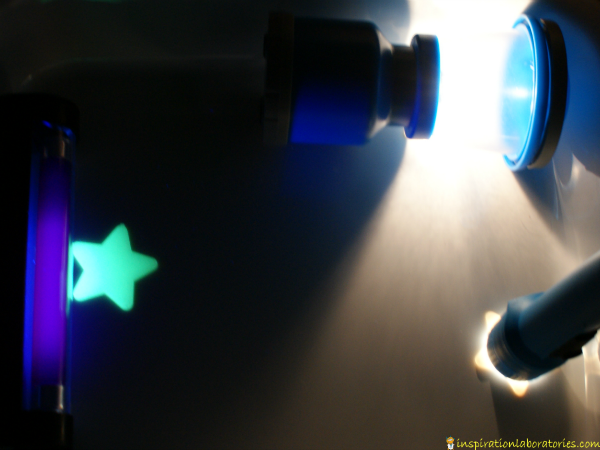
The star under the black light started glowing immediately. Here’s a close up.
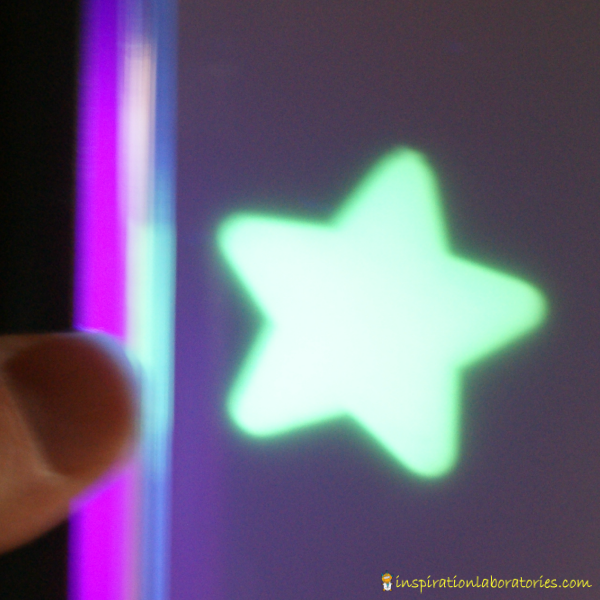
You couldn’t see the stars under the flashlights glow. The light from the flashlights got in the way. Once the flashlight was pulled away, you could see the star glow. It’s interesting to note that the star glowed brighter where the light shined on it. See how the edge of the star is dim?

Here is a side by side comparison of the stars.
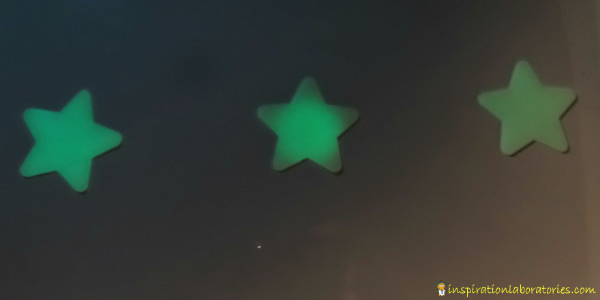
From left to right: UV light, flashlight, lantern.
With the lights we used, the UV light created the brightest glowing stars. This is what Aiden predicted would happen.
What will happen with the lights you use? Would using LED lights change things?
What Things Glow Under UV Light?
I’ve talked about the difference between fluorescence and phosphorescence when we looked at fluorescent chlorophyll. (Don’t worry about teaching toddlers and preschoolers the difference.) Fluorescence only occurs while UV light is on. Once you turn off the light, the fluorescence (or glowing) stops. Some things emit light due to phosphorescence. They will glow in the dark after the light is turned off. Glow in the dark paint, glow in the dark stars, and other things typically labeled “glow in the dark” usually phosphoresce.
Lots of things fluoresce under a UV light. Shine a black light on different objects around your house and see what you can find. Here’s a list of ideas.
Tonic water. The quinine in tonic water will fluoresce a pretty blue under a black light. You can set up a little sensory play. Pour the tonic water in bin.
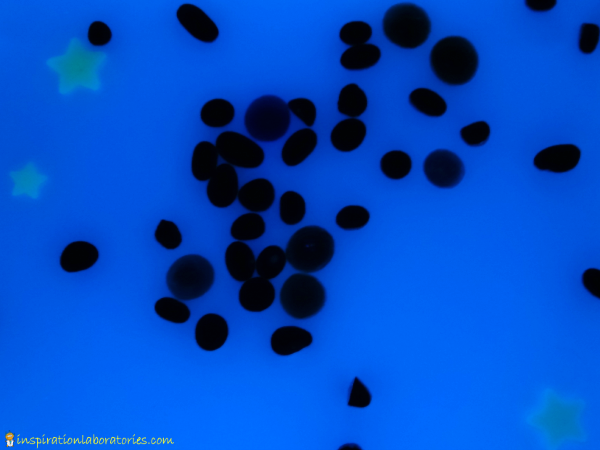
Add some other objects – rocks, stars, glass gems (whatever is safe for you child’s age). Shine the black light and watch the tonic water glow. Tonic water is sugary, so be sure to wash your hands after playing.
Vitamin B. Check out Asia’s post over at Fun at Home with Kids to see how she used Vitamin B to make glow water. And check out all of the ways she uses it.
Bananas. Yep. Black spots on bananas will fluoresce under UV light.
Toys. Lots of toys glow under a black light. Try plastic ones like Legos. Glow in the dark toys are cool to look at, too. Here are the stars under the black light.
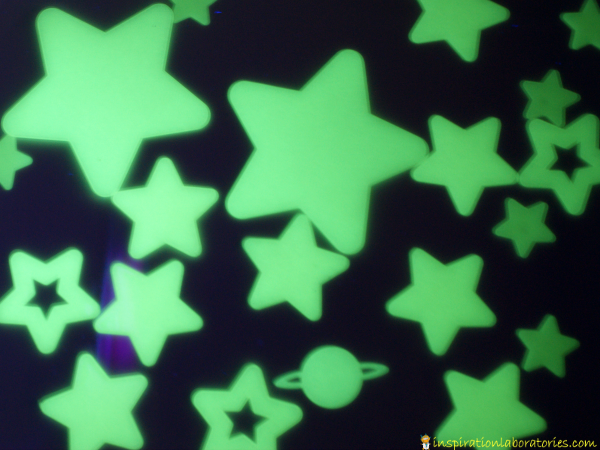
Paper. Modern white paper that is. Really old paper won’t work.
Spices and Food. Some spices and food will glow. Have fun searching for them.
Laundry detergent or toothpaste. Some of the whiteners in these items glow.
Money. To help protect against forgery, some bills ($20 and up) have parts that glow under UV light.
Rocks and minerals. Certain ones will fluoresce and some even phosphoresce. Try quartz, gympsum, talc, amber, ruby, and opal among others. Calcite is often found in concrete. Have you picked up a chunk while rock collecting?
Urine. Because of the phosphorus content, it will glow yellowish green. With kids in the house, it may or may not be fun to go check out the toilet for glowing urine.
Chlorophyll. It glows red under UV light. You’ll need to extract the chlorophyll from some leafy greens. Check out our fluorescent chlorophyll post for the how-to. It’s a cool demo but not really meant for toddlers or preschoolers.
What did you find that glows under UV light?
More Explorations with a Black Light
Glowing Oobleck – Use a black light to make some glowing oobleck.

Be sure to subscribe to our weekly newsletter and get exclusive science explorations for young scientists in each issue.
![]()

Leave a Reply